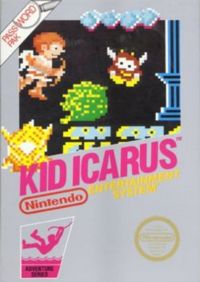Kid Icarus

| |
| Kid Icarus | |
| Developer | Nintendo R&D1 |
| Publisher | Nintendo |
| System | Nintendo Entertainment System, Game Boy Advance, Virtual Console, 3DS Virtual Console |
| Release Date | Nintendo Entertainment System JP December 18, 1986 (FDS) EU February 15, 1987 US July 1987 Gameboy Advance JP August 10, 2004 Virtual Console JP January 23, 2007 US February 12, 2007 EU February 23, 2007 KO October 28, 2008 3DS Virtual Console JP January 18, 2012 EU February 2, 2012 |
| Gallery | GH Gallery |
| Rating | ESRB: E |
Kid Icarus is a classic game for the NES that was regarded to a lost classic until it regained popularity in later years. In Japan, this game is called Hikari shinwa: Parutena no Kagami (Myth of Light: Palutena's Mirror).
Development
Toru Osawa intended the game as an action game with role-playing elements, and he specifically based it on Greek mythology. This game was made with the same game engine as Metroid, and some of the Metroid developers (including Yoshi Sakamoto) worked on Kid Icarus following the previous game's completion. In tribute to this, Metroids are in this game as an enemy, under the name "Komayto" (Mayto is short for Metroid in Japanese and "Ko" indicates Child). Although Osawa originally considered the game to be serious, Sakamoto convinced the developers to incorporate more elements of humor into the game such as the Eggplant Wizard. The game was finished only days before its release dates, and some levels apparently had to be cut in the process.
Story
In a time where gods and men lived together, Angel Land was ruled by two goddesses: Palutena, the Goddess of Light, and Medusa, the Goddess of Darkness. While Palutena helped men when she could, Medusa hated men. Medusa ruined their crops and turned them to stone. Palutena was enraged; she turned Medusa into a monster and banished her to the underworld.
Medusa spent her time in the underworld gathering an army of monsters and when the time was right, she conquered the Palace in the Sky, Palutena's home. After imprisoning Palutena, Medusa took the three Sacred Treasures and gave them to her minions. They are the Mirror Shield, the Arrows of Light, and the Wings of Pegasus.
With the last of her strength, Palutena sent a magical bow to a Pit. So, Pit must escape the underworld and rescue Palutena.
Gameplay
The game is a type of platformer in which Pit can navigate levels and fight off various monsters. His primary weapon is a bow that can fire arrows without limit. The player can also find special upgrades and other items to help progress through the levels. Despite his wings, Pit can only temporarily fly with the use of an item.
The world of Kid Icarus is divided into the underworld, the overworld, the sky world, and the Palace in the Sky. Each world has three worlds and a fortress. Each fortress has a gatekeeper that guards one of the sacred treasures. Pit's strength may increase depending on how well the player scored on the level. The game is saved through passwords, although the Japanese Famicom Disk System version can save data.
Legacy
Kid Icarus has been used as the basis of several of 9-Volt's minigames within the WarioWare series, and Pit also was included as a playable character in Super Smash Bros. Brawl after a trophy appearance in Melee. Brawl helped to popularize Pit and make there way for the revival of the Kid Icarus series in 2011.
Sequels
Kid Icarus initially had one sequel: Kid Icarus: Of Myths and Monsters for the Game Boy, which was not released in Japan. Kid Icarus Uprising was announced years later for the 3DS.
Ports and Remakes
- In 2004, Kid Icarus was ported to the Game Boy Advance in Japan as part of the Famicom Mini series.
- In 2007, Kid Icarus is available for download through the Virtual Console. A demo version was included in Super Smash Bros. Brawl as a Masterpiece.
- In 2012, it was released for the 3DS Virtual Console as a 3D Classic. This version was augmented with 3D features, including new background for all of the levels.